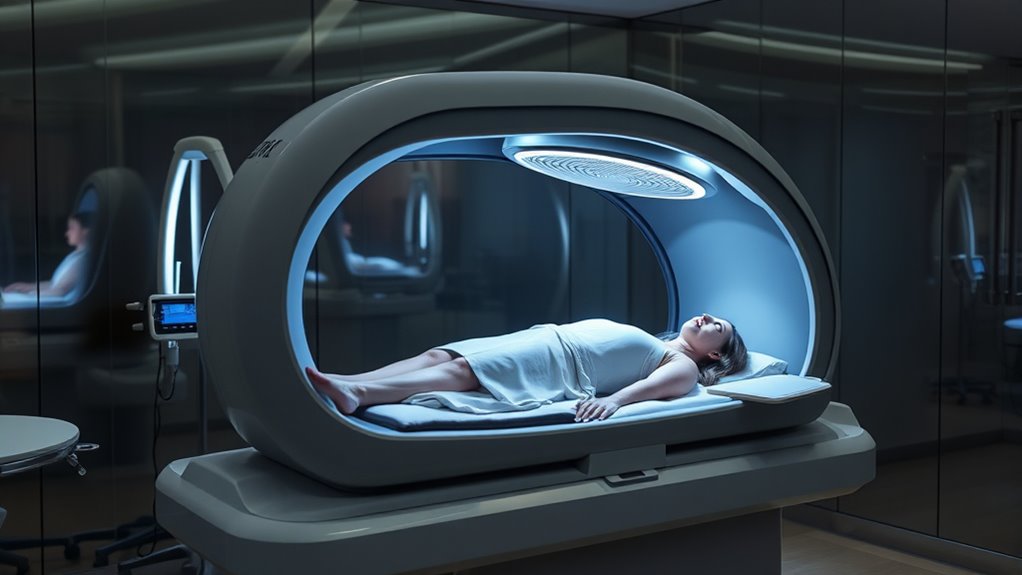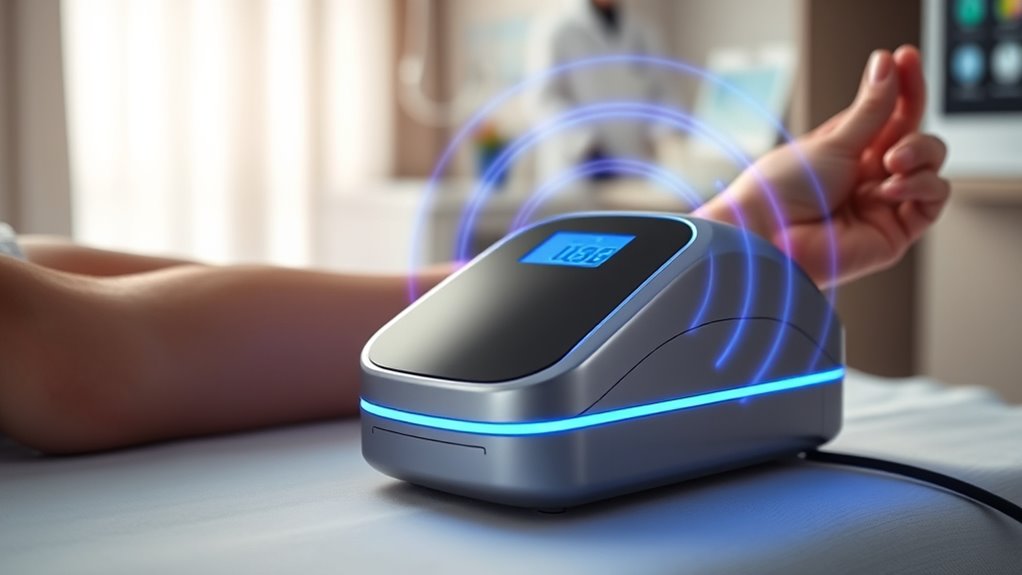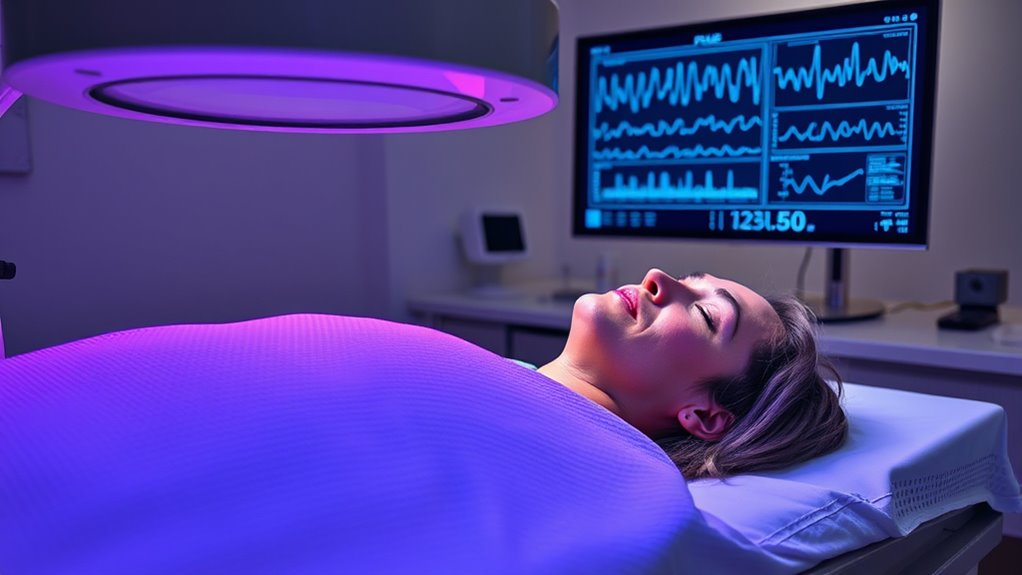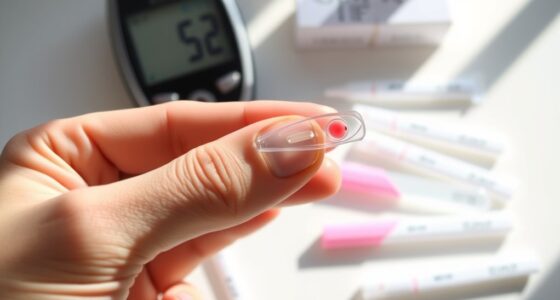PEMF therapy uses focused electromagnetic pulses to stimulate your cells, enhance healing, and reduce inflammation. It works by influencing cell electrical activity, opening ion channels, and activating signaling pathways that improve cellular function. Scientific studies support its benefits for tissue repair, pain relief, and improved mobility. Although promising, individual responses vary, and more research is needed to fully understand its mechanisms. To explore how PEMF could support your health, keep exploring further.
Key Takeaways
- PEMF therapy uses low-frequency electromagnetic pulses to stimulate cellular functions and promote tissue healing.
- It influences ion channels and membrane potentials, activating cellular signaling pathways.
- Scientific research supports PEMF’s effectiveness in reducing inflammation, improving pain, and enhancing tissue regeneration.
- Biological mechanisms include increased mitochondrial activity, calcium influx, and gene expression that support healing.
- Ongoing studies aim to clarify biological pathways and expand PEMF applications in neuroregeneration and pain management.
Understanding the Fundamentals of PEMF Therapy

To understand PEMF therapy, it’s essential to know that it uses low-frequency electromagnetic fields to stimulate your body’s cells and tissues. Historically, this approach dates back to the 19th century when scientists explored electromagnetic healing methods. Over time, technological advancements have refined how these fields are generated and applied, making treatments more precise and effective. Early devices were bulky and imprecise, but modern PEMF systems utilize sophisticated electronics and coil designs. These improvements allow for targeted therapy with minimal side effects. Today, PEMF therapy is backed by scientific research and clinical trials, demonstrating its potential for pain relief, inflammation reduction, and tissue regeneration. Understanding this evolution helps you appreciate how far the technology has come and its increasing role in holistic health approaches. Additionally, ongoing research continues to explore new applications and benefits, supported by scientific advancements that enhance treatment precision and safety.
How Electromagnetic Pulses Interact With Cells

Electromagnetic pulses influence cells by affecting their electrical and biochemical processes. When exposed to these pulses, an electric field forms around the cell membrane, impacting how ion channels open or close. These ion channels regulate the flow of ions like calcium, potassium, and sodium, essential for cellular functions. The pulses can modify the cell’s electrical potential, triggering signaling pathways and influencing cell behavior.
Electromagnetic pulses alter cell electrical activity and ion flow, triggering vital signaling pathways.
You’ll find that electromagnetic pulses:
- Alter the electric field across cell membranes
- Modulate ion channel activity
- Influence ion fluxes inside and outside cells
- Impact cell membrane permeability
- Activate cellular signaling mechanisms
Understanding these interactions helps explain how PEMF therapy can promote healing and cellular repair by directly engaging with fundamental cellular processes.
Biological Effects of PEMF on Cellular Function

PEMF therapy can boost your cellular signaling, helping cells communicate more effectively. It also increases cellular metabolism, supporting faster energy production and repair. These effects contribute to overall improved cell function and health. Additionally, emerging research suggests that PEMF may influence cellular processes related to cellular efficiency, potentially enhancing the body’s ability to recover and maintain optimal function. Furthermore, studies indicate that PEMF therapy can modulate cellular communication pathways, promoting more coordinated responses within tissues. Such modulation may also support cellular repair mechanisms, further aiding in tissue regeneration and health.
Cellular Signaling Enhancement
Cellular signaling pathways are essential for maintaining cellular health and coordinating responses to environmental stimuli. PEMF therapy enhances signal transduction by influencing receptor activation, which triggers downstream cellular responses. This process improves communication within cells, promoting proper function and adaptation. When exposed to PEMF, you may experience:
- Increased receptor sensitivity to signaling molecules
- Enhanced activation of key signaling cascades
- Improved regulation of cellular responses
- Facilitation of the release of secondary messengers
- Strengthened overall cellular communication which can support overall cellular health and resilience.
Increased Cellular Metabolism
When cells respond to PEMF therapy, their metabolic activity often increases, leading to more efficient energy production. This boost in metabolic rate helps your cells generate ATP—the body’s main energy currency—more effectively. As a result, cellular functions such as repair, regeneration, and overall maintenance improve. PEMF stimulates mitochondrial activity, which directly enhances energy production and supports cellular vitality. With a higher metabolic rate, your cells can better meet increased demands, accelerating healing processes. This increased cellular metabolism not only promotes tissue repair but also strengthens immune responses. You may notice improved energy levels and faster recovery because your cells are functioning at their best. Overall, PEMF’s ability to elevate cellular metabolism plays a key role in restoring health and vitality. Additionally, increased mitochondrial function aligns with Volkswagen Tuning principles of optimizing efficiency and performance at the cellular level. For example, enhancing mitochondrial activity can help mitigate oxidative stress, further supporting cellular health.
Scientific Evidence Supporting PEMF Applications

You can find compelling evidence for PEMF therapy in various clinical trial outcomes, which demonstrate its potential benefits across different health conditions. Biological response studies further support its effectiveness by showing how cells react positively to treatment. Together, these points build a strong foundation for understanding PEMF’s scientific validity. Additionally, research comparing PEMF with other assessment tools highlights its predictive validity, underscoring its reliability in clinical settings. Moreover, the integration of sustainable practices in research methodologies enhances the credibility and acceptance of PEMF as a therapeutic option. Incorporating energy-efficient and environmentally conscious research methods further strengthens its scientific credibility.
Clinical Trial Outcomes
How strong is the scientific evidence supporting PEMF therapy’s effectiveness? Clinical trial outcomes show promising results, but you should interpret them carefully. Many studies report high patient satisfaction, often correlating with perceived benefits. However, placebo effects can influence these perceptions, making it essential to contemplate control groups. Key findings include:
- Significant improvements in pain and mobility for osteoarthritis patients
- Reduced inflammation and faster healing in tissue repair studies
- Positive effects on bone regeneration in fracture cases
- Variability in results due to study design and sample size
- The importance of blinding to minimize placebo influences
- The use of portable devices that facilitate treatment outside clinical settings
- The mechanisms underlying PEMF’s biological effects are still being actively researched, adding to the complexity of evaluating its efficacy
- Ongoing research aims to better understand the biological pathways involved in PEMF’s therapeutic effects
While these outcomes support PEMF’s potential, more rigorous, large-scale trials are necessary to confirm its true efficacy beyond placebo effects.
Biological Response Evidence
Scientific studies demonstrate that PEMF therapy induces measurable biological responses at the cellular and tissue levels, providing a foundation for its therapeutic effects. These responses involve specific biological mechanisms that promote healing, reduce inflammation, and enhance tissue regeneration. These mechanisms activate signaling pathways that accelerate repair processes and modulate pain. You can observe cellular responses such as increased calcium influx, improved mitochondrial function, and stimulated gene expression. Such mechanisms activate signaling pathways that accelerate repair processes and modulate pain. The evidence shows that PEMF influences various cell types, including osteoblasts, chondrocytes, and nerve cells, confirming its broad biological impact. Additionally, natural materials used in therapy devices may enhance the efficacy of PEMF treatment by promoting better tissue interaction. Furthermore, research supports the use of biological response mechanisms as a basis for optimizing PEMF protocols for various medical conditions. By targeting these cellular responses, PEMF therapy supports tissue recovery and overall health. Scientific data also suggests that specific cellular responses can be tailored to individual patient needs, improving treatment outcomes. This scientific validation underscores how PEMF’s biological mechanisms translate into tangible clinical benefits.
Conditions Potentially Improved by PEMF Treatment

PEMF therapy has shown promise in alleviating a variety of health conditions by promoting cellular repair and reducing inflammation. You might find relief from chronic pain, especially in conditions like osteoarthritis, where joint inflammation and degeneration cause discomfort. PEMF stimulates blood flow and tissue regeneration, which can help ease pain and improve mobility. Many users report decreased stiffness and enhanced joint function after consistent treatment. This therapy is also explored for other conditions such as tendinitis, fibromyalgia, and sports injuries, thanks to its ability to support healing processes. If you’re dealing with persistent discomfort or joint issues, PEMF could be a non-invasive option worth considering. Its targeted energy delivery aims to restore balance and promote natural healing in affected areas.
Limitations and Considerations in PEMF Use

While PEMF therapy offers promising benefits for conditions like osteoarthritis and tendinitis, it’s important to recognize its limitations and consider factors that may affect its effectiveness. One key consideration is cost; high-quality devices can be expensive, and ongoing sessions might add up over time. Additionally, device limitations can influence results—some units may not deliver the ideal frequency or intensity needed for certain conditions. Not all PEMF devices are FDA-approved or backed by extensive research, which can impact your confidence in their safety and efficacy. Furthermore, individual responses vary, and PEMF shouldn’t replace conventional treatments without medical guidance. Being aware of these limitations helps you make informed decisions and set realistic expectations when incorporating PEMF therapy into your health routine. It is also beneficial to understand the variety of styles and sizes available in dog products, which can influence the suitability and effectiveness of therapeutic devices. Moreover, understanding device specifications such as frequency range and pulse duration can help you select the most appropriate PEMF device for your needs.
Future Directions and Emerging Research in PEMF

As research into pulsed electromagnetic field (PEMF) therapy continues to advance, new applications and technologies are emerging that could expand its clinical potential. Researchers are focusing on innovative device development to enhance treatment precision and usability, making treatments more effective. Personalized therapy approaches are gaining traction, allowing treatments tailored to individual needs and conditions. Future studies are exploring PEMF’s role in neuroregeneration, tissue repair, and chronic pain management. Advances in wearable devices could facilitate at-home use, increasing accessibility. Additionally, integration with other therapies promises synergistic effects. These developments aim to optimize PEMF’s efficacy and patient outcomes. Overall, ongoing research is paving the way for more targeted, versatile, and user-friendly PEMF solutions that could revolutionize future healthcare. Continued research is essential to fully understand and harness its potential.
Frequently Asked Questions
Are There Any Long-Term Health Risks Associated With PEMF Therapy?
You’re wondering about potential side effects and long-term safety of PEMF therapy. Currently, research indicates that PEMF is generally safe when used properly, with minimal or no adverse effects reported. While long-term safety data is limited, most studies suggest it’s a low-risk treatment. However, it’s wise to consult your healthcare provider beforehand, especially if you have metal implants or other health concerns, to guarantee safe, effective use.
How Does PEMF Therapy Compare to Traditional Treatments for Chronic Pain?
Did you know that 65% of people seek alternative pain management options? Compared to traditional treatments, PEMF therapy offers a non-invasive, drug-free approach that often results in fewer side effects. Its therapy efficacy comparison shows promising results, especially for chronic pain relief. You might find PEMF more convenient and safer, making it an attractive option if you’re exploring alternative methods to manage persistent pain effectively.
Can PEMF Be Safely Combined With Other Medical Interventions?
You can often safely combine PEMF therapy with other medical interventions, but you should consider drug interactions and contraindication considerations. Always consult your healthcare provider before starting PEMF alongside medications or treatments, especially if you’re on pacemakers, blood thinners, or have implanted devices. Your provider can assess potential risks and confirm there’s no interference, making your combined therapies both safe and effective.
What Are the Costs and Accessibility of PEMF Devices for Home Use?
Thinking about PEMF devices for home use? You’ll find that device affordability varies widely, with some options costing a few hundred dollars, while high-end models can run into thousands. Luckily, many devices are designed for home accessibility, making them more manageable and user-friendly. You can explore budget-friendly options and research different models to find one that fits your needs, ensuring safe, simple, and affordable access to PEMF therapy at home.
Are There Specific Populations That Should Avoid PEMF Therapy?
You should be aware that certain contraindications exist for PEMF therapy. Vulnerable populations, such as pregnant women, individuals with pacemakers or other electronic implants, and those with active bleeding or malignant tumors, should avoid this treatment. Always consult your healthcare provider before starting PEMF, especially if you belong to these groups. It is crucial to follow safety guidelines to prevent any adverse effects.
Conclusion
You should know that nearly 70% of users report improved pain relief with PEMF therapy. Its ability to stimulate cellular repair and reduce inflammation makes it a promising option for many health conditions. While research continues to evolve, understanding the mechanisms behind PEMF can help you make informed decisions. Keep an eye on emerging studies—this innovative treatment might just offer the non-invasive solution you’re looking for to enhance your well-being.









